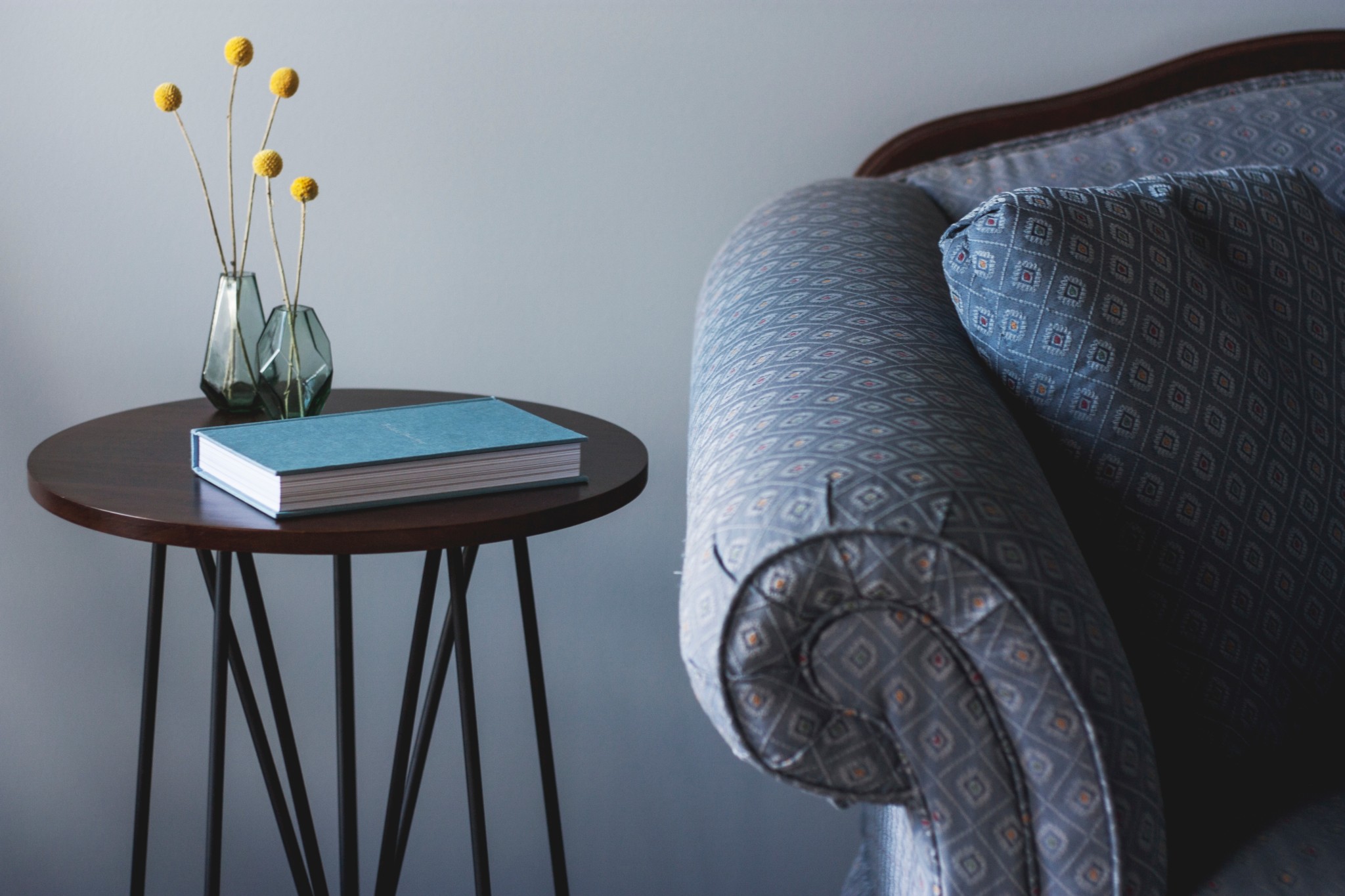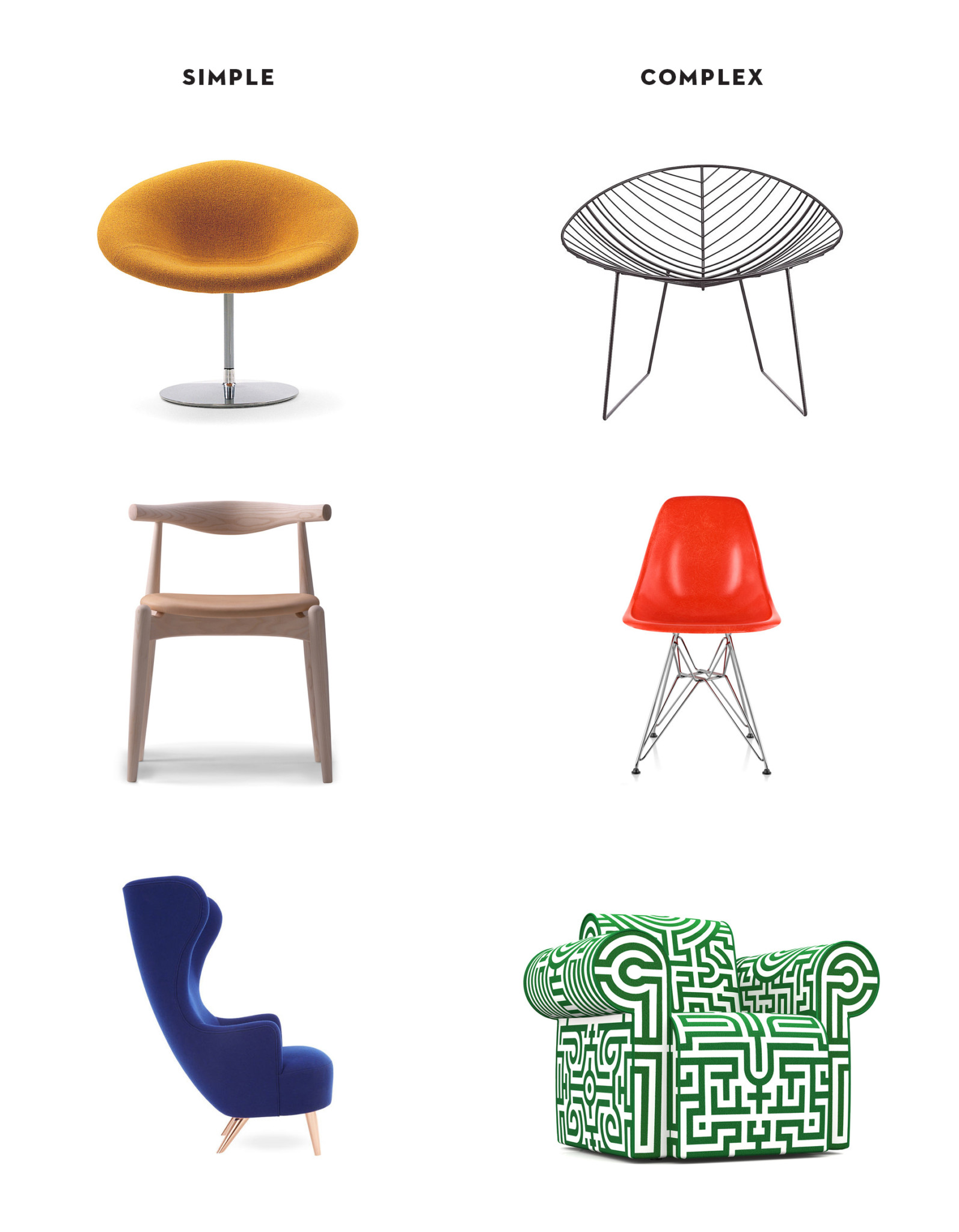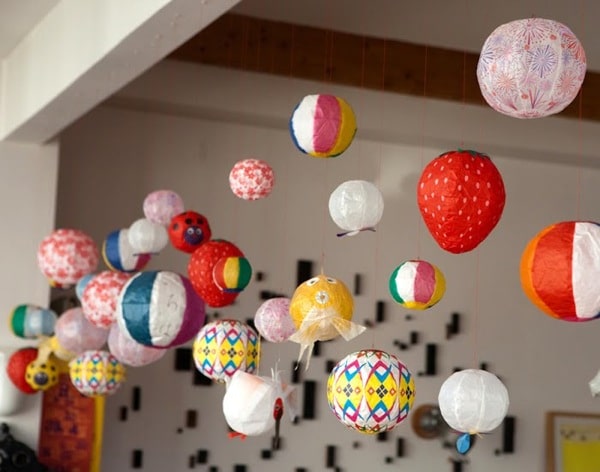We think about anxiety as a mental thing, but it’s often just as much a physical thing. It took me a long time to understand this. I used to think that if I felt anxious, the cause must be something going on in my life, in my mental life. A conflict with a friend or a big review at work: those were reasons to be anxious. They made sense.
But sometimes, I found myself feeling anxious for no good reason at all. I would feel butterflies in my stomach and start running through a list in my head, trying to figure out what I could possibly be nervous about. Some days it got so bad that my feet and hands would tingle. That’s when I learned that anxiety often comes from physical sources: too much caffeine, too little exercise, poor breathing habits. These things can cause a kind of agitation that feels to the brain like anxiety, so much so that your brain decides you must be anxious, and goes looking for things to worry about.
There are lots of ways that our homes add to our anxiety — without us even realizing it.
This was a big epiphany for me. But when I put this knowledge together with everything I’d learned about the way that our surroundings affects our emotions, I discovered that there are lots of ways that our homes add to our anxiety — without us even realizing it. This research-based list of tips has helped me create a space that eases, rather than adds to my anxiety, and I hope it will help you too.
1. Tighten up
In my old apartment, I had a lot of IKEA furniture. No shame in that, but the thing about furniture that’s held together with bolts and screws instead of joinery and welding is that over time those fasteners start to come loose. One day I was doing some work at my kitchen table and I couldn’t shake this uneasy feeling. When I got up from the table to get a snack, I noticed that my tea was sloshing around just from the movement of my standing up. I held the edge of the table and gently shook it. All the bolts were a little bit loose, making the table feel ever so slightly unsteady. It was like being on a ship instead of on firm ground.
I grabbed a set of Allen keys and went around tightening every chair, door handle, and table in the apartment. When I sat back down at my computer, the chair felt solid, and I breathed a sigh of relief.
2. Round the corners
Sharp corners activate a part of the brain associated with unconscious fear. This is likely because acute angles signaled that an object was a potential source of danger (jagged rocks, angular tree branches), so our brain puts us quietly on alert.
Sharp-edged furniture is sophisticated-looking and is often featured in beautiful home decor magazine shoots. But the last place you want to be on alert is at home. So when choosing furniture, look for circular or oval forms, or rounded rectangles that have a gentle radius on the edge. I try to do this everywhere, but it’s most important for pieces that will live in the center of a room, or in spaces where you want to be able to relax: bed, coffee table, nightstand, end tables. A simple test: if it feels like banging a toe or a shin into a piece of furniture might really hurt, it’s probably going to make you quietly anxious when you have to live with it.
What if you already have a lot of hard-angled furniture? See how it makes you feel over time, now that you’re aware of it. You may be able to use tip no. 3 (below) to soften the space up, or you might decide it’s time for a redesign.
3. Soft textures
If you’ve been craving a fluffy shag rug or a new throw blanket, here’s your excuse. Soft textures do a lot to decrease anxiety in a home. They soften a space visually, smoothing out hard edges. They also absorb sound, making the acoustics of a space warm and gentle, as opposed to jangly and agitating.
Some research also shows that when we’re in a negative mood, our brains naturally prioritize tactile stimuli over visual ones. (The hypothesis is that this tendency evolved to prompt mammals to seek out maternal or affiliative touch. Security blankets and “loveys” tap into the same drive.) So a home full of soft textures can provide relief when the going gets tough.
4. Add greenery
You knew this was coming. Nature has been shown to reduce anxiety, even in doses as small as a single potted plant. If your home doesn’t have nearby greenspace, or even if it does, adding houseplants to your space can provide a surprising degree of relief.
For those who don’t have a natural green thumb and are worried that the stress of keeping a plant alive might outweigh the benefits, here are fifteen of the easiest plants to grow.
5. Reduce complexity
A lot has been written about simplifying your life as a way to decrease stress. But I’m not talking about simplifying your space from a practical perspective (although I’m sure that’s helpful). I’m talking about simplifying it visually. This illustration of chairs may help explain what I mean. Simpler forms are more solid, more symmetrical, and use fewer patterns and materials. Complex objects tend to have more pattern and texture, less symmetry, and often have very contrasting colors and materials. The Eames are probably rolling over in their graves that I put that little red fiberglass side chair on the “complex” side. I did it because it shows how complexity can hide in simple-looking objects. All that wiry stuff going on in the base adds a lot of visual complexity that you don’t get from a chair with four basic legs like the Wegner elbow dining chair opposite it. You don’t have to only choose simple objects, but understanding when you’ve chosen a more complex design can help you balance things out by pairing it with simpler complements.
Why does complexity matter? It adds visual noise, something that people consistently rate as unpleasant when they see it in pictures of environments. Our brains like to create order and spot patterns, something that is hard when the space around us is visually distracting. I think it’s especially important because our homes have gotten visually noisier over the years due to complex-looking tech devices, the tangle of cables that comes with them, and all of the verbal clutter that accompanies the branded goods that live all over our homes.
You can reduce complexity by choosing simpler designs, arranging them in symmetrical ways, and sticking with a reasonable number of colors and patterns. Don’t take this to mean that you have to live with a grey or beige palette, which can be depressing (a topic for another post). But if you tend to pick colors and patterns that speak to you in the moment without looking at the overall picture, trying sticking with three to five colors that work together to create a harmonious palette. Other ways to reduce complexity include storing cords and devices out of sight and looking for ways to reduce the amount of packaging that you leave out on bathroom and kitchen counters.
6. Tidy up
Marie Kondo was right: tidying can offer a tremendous sense of emotional relief. Not only does it reduce frustration and cognitive load when everything has its place, but it also often works to visually simplify a space (see no. 5, above). One of the things I focus on most when trying to reduce the anxiety in my own home is something called tolerations. Tolerations are things that need attention: shoes that need to be resoled, a drawer handle that is coming loose, a pile of bills that needs to be paid. Often what we do when things need attention is we leave them out to remind ourselves to take care of them. But the effect is that we surround ourselves with a silent to do list that is constantly distracting us. How can you relax when everywhere you look is something that needs fixing, replacing, donating, etc.?
Walk around your house and make a big list of all of these tolerations. Anything you can tuck out of sight, do so, and add these items to your to do list. You might be able to tackle them all in one ambitious weekend day, or do one a day until you cross them all off. Another tip: make a kit that contains things you might need to take care of these tolerations on a regular basis. This might include WD-40 to fix a door that gets squeaky every summer, waterproofing spray for your shoes, and extra lightbulbs for a fixture that doesn’t take standard bulbs. Having these things on hand means you can take care of issues before they become tolerations.
One more reason to think about tidying up: In a study of kitchens, people spending time in a dirty kitchen ate more unhealthy snacks than those in a clean kitchen. Mess can actually trigger emotional eating.
7. Buy things that wear in, rather than out
Lastly, if you’re someone who cares a lot about the things in your home and wants them to stay in good condition, this itself can be a source of anxiety. But it is no fun worrying about whether your sister’s toddler is going to stain your sofa or whether your clumsy friend is going to chip your glass table. Some people just don’t care, but if you do, you can save yourself a lifetime of stress by following this simple rule: Buy things that wear in rather than out.
This has a lot to do with materials. One crack in a glass table, and the whole thing is useless. But scratches in a wood table deepen the character of the piece. Brass and weathered copper become more beautiful with use, but shiny chrome looks dingy and smudgy when handled. Silks and satins are easily stained and not-so-easily cleaned. Linens, cottons, and velvets develop a soft, worn-in look that makes them feel more welcoming with time.
You can save yourself a lifetime of stress by following this simple rule: Buy things that wear in rather than out.
I hope some of these ideas help make your home more of a happy place. If you have your own tips for reducing anxiety at home, please share them here or on Instagram with hashtag #joyspotting.
Images: blue sofa with table by Kari Shea; yellow sofa by Christelle Bourgeois; chairs all from Hive Modern, clockwise from top left: Pierre Paulin little globe chair, Leaf lounge, Eames side chair, Labyrinth chair, Tom Dixon wingback, Hans Wegner elbow chair.
Want to get this post as a downloadable guide? Grab it here.









Discussion (12 Comments)
I loved this post; thank you. What would you say about living with someone who has a higher tolerance for visual clutter than you do? I try to ignore it instead of nagging, but nothing really gets changed that way.
Hi Tovah, thanks so much for your comment. It’s a really good question, and a tough one! A few ideas:
– Can you designate certain areas to be clutter-free zones?
– Can you identify patterns of clutter that you can tackle through better storage? For example, the entryway to the house is often a place that can catch clutter before it moves deeper into the house. Do you have a place where you can put shoes, coats, mail, packages? Could you make those spots easier and more accessible? If you can design ways so that it’s just as easy to not have a place be cluttered than to have it be cluttered, that could take care of the problem without nagging.
– I am a big fan of storage with doors or drawers that close as opposed to open shelves, which function not only as storage, but also as display. Doors let you hide things that you’d otherwise have to organize neatly.
– Lastly – my husband and I have a funny thing we do at home, where we have an equally low tolerance for clutter, but we tend to have different areas that bother each of us. We joke about a mythical “third roommate” that lives with us and is the messy one. Sometimes we use it to call out each other’s behavior, as in, “The roommate is at it again. Leaving his stuff all over the living room!” But we also use it to acknowledge when we ourselves have been messy. For example, if I know my pile of clothes in the bedroom is out of control, I might say, “Can you believe this roommate? What a mess! I really hope she plans to get her act together this weekend.” Which is kind of code for, “Hey, I’m sorry my clothes are everywhere, please bear with me, I promise I’ll clean up this weekend.” Maybe it sounds really silly but it makes us laugh and makes it easy to both ask for a change in behavior and acknowledge when you’ve been inconsiderate…
Hope some of that helps. I’d love to know what else you may have tried.
Great post. It reminds me of the clutter I am tolerating and ways to get rid of it. Many thanks.
Thanks so much, Joanie! Good luck with your clutter 🙂
Marie Kondo advises us to get rid of anything that doesn’t spark joy. After hours in the house looking for things I realized the terrible truth…too many things spark joy for me. It’s a problem.
Haha, it’s true. That’s certainly the case with our books! I know other people who are like that with clothes. I don’t think it makes sense to be too strict about it, though worth going through the exercise!
Hi Ingrid!
For days I have been searching the internet trying to find papers, websites, and articles that talk about the psychological effects of design, and how we can use design to influence certain behaviors. I was so happy when I found this article (and website) because you put into words a lot of what my intuition was telling me already, but that I also couldn’t prove (like the bit about soft textures evoking a sense of security). I am a student, and I was wondering if you could recommend any books that talk more in depth about these subjects? I especially love the research about the natural tendencies that humans share with other mammals.
Thank you!
-Lauren
I am enjoying your website so much! And this particular article has clarified so much for me, e.g. why I cannot relax unless I tidy up the place first. The “tolerations concept rings so true and so familiar! Plus, the aesthetics of your site and quality of texts also add to a general feeling of harmony in a chaotic world. Thank you!
Ingrid—I love your posts, and this one is especially powerful.
Our busy lives tend to leave us feeling too exhausted to deal with just one more thing at home. This is a great reminder to spend a little more energy to save us the energy that would otherwise be spent on anxiety from our environment. Thanks so much!
Interesting about the patterns. I tried the “neutrals” thing and it didn’t work for me; I became color starved. So now I use color. But I have never gotten comfortable with a lot of pattern… it just feels too busy and chaotic. I can take one pattern at a time, at most, and it’s often an animal print.
Despite making notes on yellow stickers to remind myself, an urgent job, however small is not done, or can be missed inadvertently, like sending a cheque in time, making e-payments, charging the smartphone, or collecting clothes from the dry-cleaner. Nothing makes one more tense than finding oneself in such a situation at a time when one is rushing out from home, etc. You always feel a frustrating sense – how could you miss it?
Suppose you have met some people and invited them home, on the spur of the moment, just for a chat over a cup of tea, it may give you some tense moments to take note of some disorder at your home obviously because you didn’t tidy up when you left home. To take care of any such eventuality, my wife has an unbroken habit to put things in perfect order when we leave home. I used to question her why can’t she do the same tidying up after returning home to save time. But I realized the great feeling that we have when we make an entry with sudden guests who find all things organized, and spick and span.
It not only gives us peace but also saves some anxiety, if we can fix a leaky tap dripping water which is making hissing noise in the middle of the night. Similar is the case of fixing a squeaky door. The doors often get a bit loose at the hinges due to their sheer weight, resulting in an extra effort to pull them to shut. An easy thing to do to smoothen the door-closure is to put a drop of oil on the active portion of the hinge. Then, I keep a cellotape handy to keep small things from falling apart, before they can be repaired, eventually.
At home, use of not only soft textures, but soft colors for tapestry furnishings, and soft lighting helps to keep anxiety at bay. We have put a mood-uplifting wall-paper in the living room, and matching chandeliers and wall lights, too. And we have a large wall clock (grandfather) and antique folding stools alongside the sofa, to set the mood. Dusting the furniture and getting a varnish-coat regularly, is a great idea. Then, we have added a lot of greenery in our large balcony, with flower plants blooming and green plants splashed all over. Everyday we water them and spruce them up generally.
And for living in a high-rise building, a first floor flat is ideal – lifts not needed and one can see far towards a park, etc., and watch children playing in the evenings – very refreshing.
I do agree with, ‘How can you relax when everywhere you look is something that needs fixing, replacing, donating?’ I keep de-cluttering regularly. For instance, I have donated used items to needy people: a refrigerator, a cupboard, a washing machine, a laptop, a digital camera, all getting outdated but in working condition. And, buying new shoes in the shopping mall also means getting rid of some old pairs.
“Buy things that wear in rather than out”!. We have furniture and accessories that do not look used but get welcome looks from users. Crockery is better without sharp edges. Cutlery with no crevices. And we need tea cups that are not too small or too large, and elegant to feel nice.
More than the sharp-edged furniture (which I make sure to get rounded anyway), I worry if I am sitting too high or too low for my neck not to suffer when I spend long hours at home on my PC/laptop. Going for a small walk everyhalf hour is the standard advice, but it is also too obvious. A chair with just the right height and swivel is a must, to keep my spine in good condition. Often times people struggle when they have to urgently print a few pages on a holiday at home. Either the printer is out of order, or the blank paper sheets are over, or the ink-cartridge has not been replaced. I keep attending to all these things in order to have a peace of mind. Then, I do keep a spare laptop at home, in case something went wrong and the main laptop didn’t work at a very odd hour. The to cover the anxiety of losing all my stored files, 82 GB of them in all, on my home laptop (which is also carried to the workplace at my job), I do copy them every 20 days or so on spare flat discs (1 TB capacity). Goal is zero-anxiety!
How many times you meet people in an elevator or in the lobby of your residential tower, who suddenly make a statement that they need to go back to their flat since they are not sure of having locked the main door? Zero anxiety levels are not easy to achieve, after all!
We humans are hard-wired to worry, to be anxious. Anticipation of anything untoward hounds us. Anxiety is woven into our actions when we are waiting for things to happen, whether at home, in office, or while traveling, etc. I give just two examples.
First example is of a speaker, however famous and experienced, a few minutes before going to the stage to deliver his/her talk or lecture. Many speakers anticipate disasters. Will the projections come nicely on the screen displaying it? Will the animation work? Is their a collar microphone available? Am I audible to the last rows of the auditorium? And so on. I am told these small anxieties prior to the delivery of a talk are signs of a well-prepared talk, which the speaker wishes to make sure to be successful.
Second example deals with the misery that we self-impose on ourselves before leaving home for the airport to catch a flight. Will my Uber taxi arrive in good time to leave for airport? This, when I keep a buffer of one hour extra, unlike some people who board a taxi for airport palpably delayed, managing to reach the airport just 5 minutes before the check-in counter closes. Having reached the airport I worry if the queue before me is moving reasonably fast before I reach the check-in counter? Have I locked my suitcase before handing it in? Did I put all materials like a phone, etc. safely in the cabin bag before putting it on the x-ray tray? Walking up the ladder to board the plane I wonder whether I will get space in the overhead bin to place my bag, or people ahead of me would have filled the space right above me? When I sit in the isle seat (my favorite), I keep anxiously watching if an incoming passenger will not hit me with his/her backpack while he/she makes some violent turns left and right to check the bin space or their seat numbers as they move on. After deplaning, I am anxious if I would have to walk a long distance with my handbag or I will get an electric buggy? When will my luggage come on the luggage belt, when a majority have already picked theirs and gone? Will I get a taxi easily to go to my destination?
Do I live on worries?